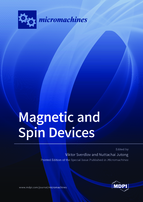Magnetic and Spin Devices
A special issue of Micromachines (ISSN 2072-666X). This special issue belongs to the section "D1: Semiconductor Devices".
Deadline for manuscript submissions: closed (1 September 2021) | Viewed by 13662
Special Issue Editors
Interests: digital spintronics; spin-transfer torque devices; spin-orbit torque devices; in-memory computing
Special Issues, Collections and Topics in MDPI journals
Interests: DFT; spintronics; spin orbit torque; multiscale modeling; terahertz spintronic devices
Special Issues, Collections and Topics in MDPI journals
Special Issue Information
Dear Colleagues,
As scaling of electronic semiconductor devices displays signs of saturation, the main focus of research in microelectronics shifts towards finding new computing paradigms. The electron spin offers additional functionality to digital charge-based devices. Several fundamental problems including spin injection to a semiconductor, spin propagation and relaxation, as well as spin manipulation by the gate voltage have successfully been resolved to open a path towards spin-based reprogrammable electron switches. Devices employing the electron spin are non-volatile; they are able to preserve the stored information without external power. Emerging nonvolatile devices are electrically addressable, possess a simple structure, and offer endurance and speed superior to flash memory. Having nonvolatile memory very close to CMOS offers a prospect of data processing in the nonvolatile segment, where the same devices are used to store and to process the information. This opens perspectives for conceptually new low power computing paradigms within Artificial Intelligence of Things (AIoT).
This Special Issue focuses on all topics related to spintronic devices such as spin-based switches, magnetoresistive memories, energy harvesting devices, and sensors which can be employed in in-memory computing concepts and in the Artificial Intelligence of Things paradigm.
Dr. Viktor Sverdlov
Dr. Nuttachai Jutong
Guest Editors
Manuscript Submission Information
Manuscripts should be submitted online at www.mdpi.com by registering and logging in to this website. Once you are registered, click here to go to the submission form. Manuscripts can be submitted until the deadline. All submissions that pass pre-check are peer-reviewed. Accepted papers will be published continuously in the journal (as soon as accepted) and will be listed together on the special issue website. Research articles, review articles as well as short communications are invited. For planned papers, a title and short abstract (about 100 words) can be sent to the Editorial Office for announcement on this website.
Submitted manuscripts should not have been published previously, nor be under consideration for publication elsewhere (except conference proceedings papers). All manuscripts are thoroughly refereed through a single-blind peer-review process. A guide for authors and other relevant information for submission of manuscripts is available on the Instructions for Authors page. Micromachines is an international peer-reviewed open access monthly journal published by MDPI.
Please visit the Instructions for Authors page before submitting a manuscript. The Article Processing Charge (APC) for publication in this open access journal is 2600 CHF (Swiss Francs). Submitted papers should be well formatted and use good English. Authors may use MDPI's English editing service prior to publication or during author revisions.
Keywords
- digital spintronics
- spin-transfer torque (STT)
- spin-orbit torque (SOT)
- magnetoresistive random access memory (MRAM)
- in-memory computing
- magnetic sensors
- energy harvesting magnetic devices
- artificial intelligence of things
Related Special Issues
- Magnetic and Spin Devices, Volume II in Micromachines (11 articles)
- Magnetic and Spin Devices, 3rd Edition in Micromachines (2 articles)








